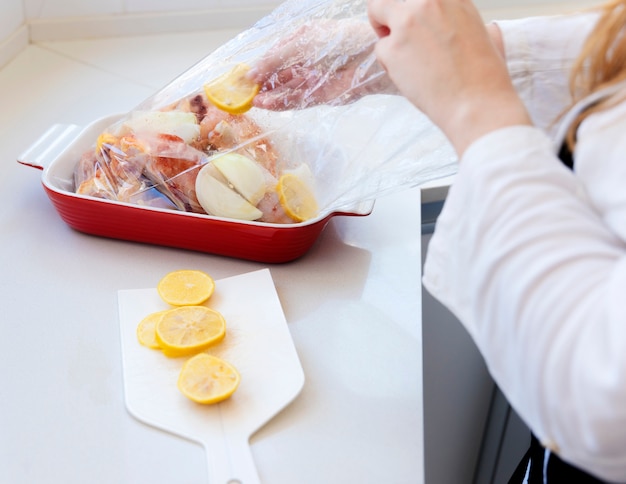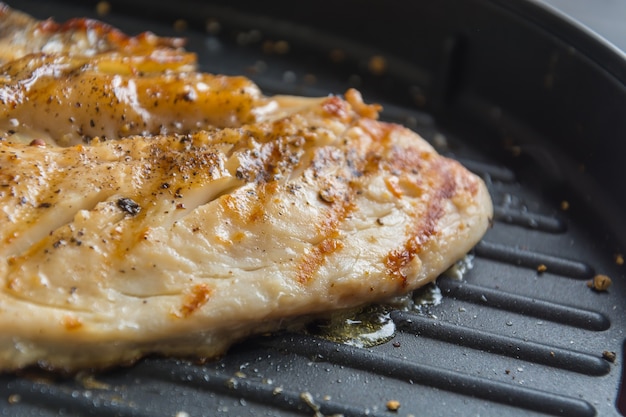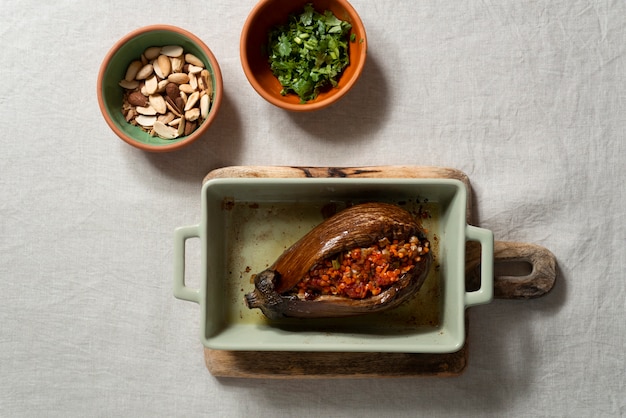Let’s face it, there’s something undeniably satisfying about a perfectly cooked pork fillet. It's juicy, tender, and boasts a delightful crispy skin that makes your mouth water. But, as with any culinary feat, mastering the art of oven-roasting a pork fillet takes practice and a few key insights. I’ve been on this journey myself, experimenting with different techniques, stuffing variations, and even daring to go beyond the traditional oven roast. So, grab a comfy seat, and let’s embark on a culinary adventure together. I’m going to share my secrets and tips, guiding you to create a pork fillet roast that will have your friends and family begging for more.
Part 1: The Foundation - Choosing the Perfect Fillet

Before we even think about turning on the oven, we need the right foundation - a top-quality pork fillet. This is where a good butcher is your best friend. They're the experts, able to guide you to the most succulent, flavourful cuts. I always head to my local butcher, chatting with them about what’s freshest and best for the type of roast I’m envisioning. Look for a fillet that’s thick, ideally around 1.5kg, as it offers the best balance between cooking time and overall tenderness.
The Importance of Freshness: A Culinary No-No
It sounds like a no-brainer, but freshness is crucial. You want that vibrant pink colour, the slight marbling that hints at a well-fed pig, and most importantly, a light, fresh aroma. There’s nothing worse than biting into a pork fillet that’s past its prime – it just ruins the entire experience. I've learned this the hard way, and trust me, it’s a culinary faux pas you want to avoid at all costs.
Knowing Your Pork: The Telltale Signs of Quality
When choosing your pork fillet, pay attention to these key indicators:
- Color: A pale pink hue is a good sign. Avoid fillets that are overly pale, as they may be dry.
- Marbling: The presence of white streaks, known as marbling, signifies fat content, which adds flavour and tenderness.
- Smell: A fresh, clean smell is a must. If you detect any strong, unpleasant odor, skip that fillet.
Part 2: Prepping the Fillet - Laying the Groundwork

Now that you’ve got your beautiful pork fillet, it's time to get down to business. Prepping is like setting the stage for a fantastic performance – it needs to be precise and meticulous. First, I give the fillet a gentle scrub with a damp cloth to remove any loose bits. Then, I pat it dry with some kitchen paper. This is important because it removes excess moisture, preventing steam from forming in the oven and ensuring a lovely crispy skin.
Seasoning with Flair: The Art of Flavour
This is where your creativity shines! I always start with a generous sprinkling of salt and black pepper. Then, the fun begins. I love experimenting with herbs and spices, crafting flavour profiles that complement the pork’s natural sweetness. Some of my favourite combinations include:
- Rosemary and thyme: A classic pairing that infuses the pork with a warm, earthy aroma.
- Garlic powder and paprika: A punchy combination that adds a hint of spice and a vibrant red hue.
- Sage: A traditional choice that brings a slightly peppery and pungent flavour to the pork.
Stuffing or Not? A Matter of Taste
This is a personal preference, but I’m a huge fan of stuffing. It elevates the pork fillet to another level of culinary delight. I’ve experimented with countless combinations, from traditional sausage meat with herbs and spices to more adventurous options like:
- Apple and apricot: A sweet and tangy stuffing that complements the pork beautifully.
- Chorizo and apple: A bold, flavourful stuffing that packs a punch.
Part 3: The Oven's Call - Getting Ready to Roast

The anticipation is building! It’s time to get the oven fired up. Preheat it to 190°C/375°F. This ensures a consistent heat that cooks the pork fillet evenly and produces that golden, delicious crust we’re aiming for. I find that a fan oven helps to distribute the heat more efficiently, but a regular oven will do the trick. The key is to have a hot oven ready to embrace the pork fillet.
The Right Dish: A Foundation for Perfection
I always use a roasting tin for my pork fillet. It provides ample space for the heat to circulate and ensures even cooking. If you’re feeling fancy, you could use a casserole dish with a lid. This helps to lock in moisture and keep the fillet tender. But, really, a simple roasting tin is more than sufficient. Just make sure it’s big enough to accommodate the fillet comfortably.
Adding a Touch of Fat: The Secret to Crispy Skin
This is where we get the crispy skin we’ve been talking about. You can use slices of streaky bacon, some butter, or even a drizzle of olive oil. The fat acts as a barrier between the fillet and the heat, preventing it from drying out. I usually opt for a combination of bacon and olive oil - a beautiful marriage of flavour and crispness.
Part 4: The Cooking Time - A Crucial Step
Alright, the oven is hot, the fillet is prepped, it's showtime! I usually roast my pork fillet for around 20 minutes per 500g, plus an extra 15 minutes. But, here’s the crucial part: always check the internal temperature with a meat thermometer. You want it to reach 63°C/145°F. This ensures it’s cooked through and safe to eat.
Resting Time: The Secret to Tenderness
After the fillet is cooked, don’t rush to carve it! Let it rest for about 10-15 minutes. This allows the juices to redistribute, resulting in a more tender and flavorful fillet. While it’s resting, I get my carving board and knives ready, eager for the moment when I can slice into that juicy masterpiece.
Part 5: Beyond the Basic Roast - Exploring New Techniques
So, you’ve got your basic oven roast down pat. Now, let’s explore some exciting techniques that add another layer of depth and flavour to your pork fillet. One of my favourites is searing the fillet before roasting. This creates a beautiful, crispy crust and enhances the overall taste.
Searing for Depth: A Culinary Trick
Before popping the fillet into the oven, heat a generous amount of oil in a pan over high heat. Sear the fillet for a few minutes on each side, until it’s nicely browned. It’s a simple step, but it adds a remarkable depth of flavour and that satisfyingly crispy texture we all crave.
sous vide cooking: The Ultimate in Precision
If you’re feeling adventurous, try sous vide cooking. It’s a bit more involved, but the results are truly incredible. You cook the fillet in a water bath at a constant temperature, resulting in incredibly even cooking and exceptional tenderness. I find sous vide to be a fantastic way to cook pork fillet, as it’s practically foolproof and delivers a perfectly cooked result every time.
Glazes and Marinades: Elevating the Flavour
Speaking of flavour, let’s talk about glazes and marinades. They’re the finishing touches that elevate your pork fillet to new heights. I’m a big fan of brushing the fillet with a honey and mustard glaze towards the end of cooking. It creates a beautiful, caramelized crust and adds a touch of sweetness. For a more exotic twist, try a ginger and soy marinade. Its bold, aromatic flavour complements the pork beautifully.
Part 6: The Grand Finale - Serving Up the Feast
The moment has arrived! Your pork fillet is cooked to perfection, rested, and ready to be carved. Now, it’s time to assemble the feast. I always serve my pork fillet with a medley of roasted vegetables. sweet potatoes, carrots, and parsnips are my go-to choices, but feel free to experiment with your favourites. A dollop of gravy is a must, adding richness and flavour to the entire dish.
Carving the Fillet: A Culinary Art
Use a sharp knife to slice the fillet into thick slices. This prevents the meat from falling apart and allows each slice to retain its juicy tenderness. If you’ve stuffed your fillet, make sure you slice through the stuffing as well. It’s a beautiful thing to see, a symphony of colours and textures that tantalizes the senses.
Finishing Touches: A Splash of Elegance
Once you’ve carved the fillet, it's time to add the final touches. I love to sprinkle some fresh herbs over the top, like rosemary or thyme. They add a beautiful aroma and a touch of freshness. If you’re feeling fancy, a drizzle of balsamic vinegar or a squeeze of lemon juice adds a touch of elegance.
Part 7: A Culinary Symphony - Accompanying Dishes
A truly memorable roast dinner needs a supporting cast – the side dishes. I always aim for a balanced meal that satisfies the palate and leaves everyone feeling contented.
Vegetables: A Colorful Palette
Roasted vegetables are a classic pairing for pork fillet. I’ve already mentioned sweet potatoes, carrots, and parsnips, but other excellent options include:
- Brussels sprouts: A surprisingly versatile vegetable that roasts up beautifully.
- Asparagus: Offers a delicate, earthy flavour that complements the pork.
- Cauliflower: A blank canvas for flavour, easily roasted and enhanced with herbs and spices.
- Root vegetables like beetroot and turnips: Add a vibrant burst of colour and unique flavour to the plate.
Salads: A Light and Refreshing Touch
For a lighter touch, a salad is a great option. I love a simple green salad with a vinaigrette dressing. Feel free to add some fruit like grapes or berries for a touch of sweetness. A salad with a bit of crunch is also a nice addition. Try adding some toasted nuts or seeds for extra flavour and texture.
Starchy Sides: The Perfect Complements
No roast dinner is complete without a starchy side dish. You could go for mashed potatoes, roast potatoes, or even a Yorkshire pudding. I personally adore roast potatoes. Their crispy exterior and fluffy interior soak up all the delicious juices from the pork.
Part 8: The Leftover Magic - Turning Leftovers into Treats
You’ve created a delicious roast, but there’s leftover pork fillet – don’t let it go to waste! Leftovers are a culinary treasure trove, and with a little imagination, they can be transformed into new and exciting dishes.
Sandwiches: A Classic comfort food
Who doesn't love a good pork sandwich? Slice up the leftover pork and create delicious sandwiches. I like to add some mayonnaise, mustard, and lettuce for a classic pork sandwich. You could also add some roasted vegetables, or even some cheese for a more decadent treat.
Salads: A Fresh and Flavorful Option
Leftover pork fillet is fantastic in salads. Chop it up and add it to a green salad, a grain salad, or even a pasta salad. It adds a boost of protein and flavour. I love to add some leftover roast vegetables to my salads as well, it’s a great way to use everything up.
Soups: A Warm and Hearty Meal
You can use leftover pork to make a delicious soup. It adds a lot of flavour and body to the soup. I like to make a simple pork and vegetable soup. You could also add some noodles or rice to make it a more substantial meal.
Part 9: Frequently Asked Questions
Q: How do I know if my pork fillet is cooked through?
The best way to tell if your pork fillet is cooked through is to use a meat thermometer. The internal temperature should reach 63°C/145°F. If you don’t have a meat thermometer, you can check the colour of the meat. It should be a nice, even pink colour throughout. Avoid overcooking the pork fillet, as it will become dry and tough.
Q: How long should I rest my pork fillet for?
It's a good idea to rest your pork fillet for at least 10-15 minutes before carving. This allows the juices to redistribute, resulting in a more tender and flavourful fillet.
Q: What are some good marinades for pork fillet?
There are tons of great marinades for pork fillet. Here are a few ideas:
- Honey and mustard marinade:
This is a classic marinade that's sweet and tangy. It's easy to make and it always goes down well. Simply combine honey, mustard, and a little bit of olive oil.
- Ginger and soy marinade:
This is a more exotic marinade that's bold and aromatic. It’s a fantastic way to add a bit of zing to your pork fillet. Combine ginger, soy sauce, and a little bit of garlic.
- Lemon and herb marinade:
This is a light and refreshing marinade that's perfect for summer. Combine lemon juice, olive oil, and your favourite herbs.
Q: Can I freeze leftover pork fillet?
Yes, you can freeze leftover pork fillet. It will last for about 2-3 months in the freezer. When you’re ready to use it, thaw it in the fridge overnight.
Q: How do I make a crispy pork skin?
To make a crispy pork skin, you need to ensure the skin is dry. Pat the fillet dry with kitchen paper, and then score the skin with a sharp knife. This helps the fat to render out and the skin to crisp up. You can also rub the skin with a little bit of salt, which helps to draw out the moisture.
I hope you've found my tips and tricks useful for roasting your next pork fillet. It's a truly versatile cut of meat that can be cooked in so many ways. Remember, have fun with it, experiment with different flavours and techniques, and most importantly, enjoy!
Everyone is watching

Corn on the Cob: The Ultimate Guide to Perfectly Cooked Ears
Healthy MealsAh, corn on the cob. Just the name evokes images of sunny days, barbecues, and that sweet, juicy flavour that ...

Perfect Pork Roast Oven Cooking Time: A Guide to Delicious Results
Healthy MealsThere's something truly satisfying about a perfectly roasted pork. The aroma alone is enough to make your mout...

Ham Cooking Time: How Long to Bake, Smoke, or Boil a Delicious Ham
Healthy MealsAh, ham. It's a classic, isn't it? A real crowd-pleaser, especially around holidays. And when done right, it'...

Scallops: The Ultimate Guide to Perfect Cooking
Healthy MealsAh, scallops. Those delicate, sweet, and utterly delicious morsels of the sea. They hold a special place in my...

Spaghetti Squash: The Ultimate Guide to Cooking and Serving
Healthy MealsRemember that time you saw spaghetti squash at the supermarket, looking all bumpy and strange, and thought, "W...
